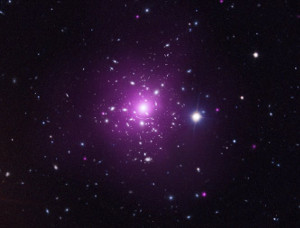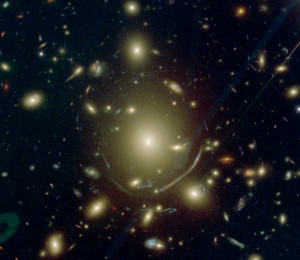
A composite optical and X-ray image of Abell 383, one of the 7 relaxed rich clusters considered in the study by Newman et al. 2013a,b. This image shows the X-ray emission of the hot electron gas in the cluster (in purple), its member galaxies and its central Brightest Cluster Galaxy which exhibits an extended diffuse envelope of stars around it. 
A zoom on the BCG in Abell 383 taken with the Hubble Space Telescope. The central BCG is surrounded by an extended envelope of stars and the numerous distorted images around it are background galaxies which are getting lensed by the cluster. Because of their high masses, galaxy clusters can act as gravitational lenses: the background galaxies close to the line of sight of the cluster get multiply imaged or distorted into large arcs like the one visible south of the BCG. Some of the cluster galaxies (e.g. the bright elliptical galaxy one on the south-east of the BCG) act as additional lenses which further distort some of the multiple images. Dark matter is at the centre of our understanding of the physics of the early Universe, of cosmic large-scale structure and of galaxy formation. In its simplest form, "cold dark matter" consists of non-relativistic weakly interacting particles of a kind not included in the standard model of particle physics. On astrophysical scales the dark matter only interacts with baryons (ordinary matter) through the force of gravity. Because of the simple physics this entails, its dynamics and clustering can be followed through N-body simulations. Recently, scientists at the MPA have performed cosmological N-body simulations showing that the mergers of galaxies (containing both stars and dark matter) at the centre of galaxy clusters can alter the central distribution of dark matter in a way that alleviates recent discrepancies found between observations and simulations. Galaxy clusters are objects of prime interest to study dark matter because they give astronomers the largest number of independent probes of halo structure (stellar kinematics, strong gravitational lensing, weak gravitational lensing, X-ray emission from hot gas, galaxy motions). This helps considerably in obtaining robust and precise results which can put firm constraints on total mass profiles. Recent observations of galaxy clusters and of their central galaxies (Brightest Cluster Galaxies or BCGs) have combined a number of probes, revealing that the clusters' total density profiles are well described by the "universal" profile found in cosmological dark-matter-only simulations. However, their dark matter profiles are systematically shallower in the innermost regions (well inside the visible BCG). For a little more insight into the project see this: http://www.mpa-garching.mpg.de/mpa/research/current_research/hl2014-11/hl2014-11-en.htm |
